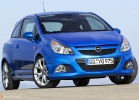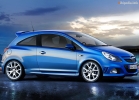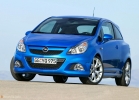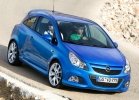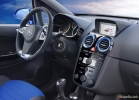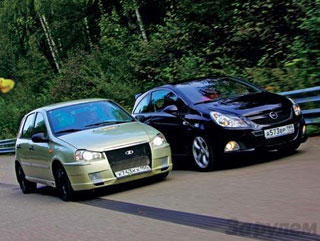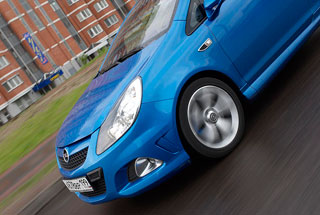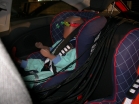Opel Corsa OPC test drive since 2007 hatchback
Bold blue, Opel Corsa OPC test
 Opel Corsa's low -iority has long become confused and is rightfully considered a female machine. To match her and the choice of engines, from liter to 1.4 liters. And what if the owner has grown out of the car or wants not like everyone else? For such cases, the manufacturer from Ryusselshaim prepared the magic blue letters OPC. A little more than ten years ago, the Opel plant created the Performance Center unit, which specializes in the factory tuning of the entire lineup. Nothing unusual in that this happened in Germany. It is the Germans that are the largest fans of all kinds of improvements, such as the installation of anti -wing, turbines and sports seats. This industry originated in West Germany more than 30 years ago, and former racers and mechanics from motorsport are engaged in it.
Opel Corsa's low -iority has long become confused and is rightfully considered a female machine. To match her and the choice of engines, from liter to 1.4 liters. And what if the owner has grown out of the car or wants not like everyone else? For such cases, the manufacturer from Ryusselshaim prepared the magic blue letters OPC. A little more than ten years ago, the Opel plant created the Performance Center unit, which specializes in the factory tuning of the entire lineup. Nothing unusual in that this happened in Germany. It is the Germans that are the largest fans of all kinds of improvements, such as the installation of anti -wing, turbines and sports seats. This industry originated in West Germany more than 30 years ago, and former racers and mechanics from motorsport are engaged in it. Opel Corsa OPC is a bright embodiment of factory tuning according to a classic recipe. We take a massive low-profile and through the installation of the turbine we force a 1.6-liter engine to almost 200 forces! Many street offices would have limited themselves to this, but the specialists from Opel honor the rules. It is known that an increase in power should certainly lead to a comprehensive processing of the car. Consequently, the car received an underestimated suspension with sports shock absorbers, stabilizers wider and reinforced brakes. In conclusion, decor elements: stylish aerodynamic body kit, large wheels, sports steering wheel, recaro seats and pedal overlays. In addition, unrelated external mirrors in the DTM style and decorative diffuser. It turned out boldly. We will taste the dish?
 I unlock the massive door, sit in the deep bucket of Recaro and fasten, along the way, noting that it is very inconvenient to reach behind the belt (the benefit there are hooks on the backs where the strap can be attached after the trip). The interior practically repeats the usual Corsa in a rich configuration. Of the changes, there is a sports steering wheel with a trimmed lower part and the OPC marks on the instruments and a checkpoint handle. In general, the salon is made with taste, but cold technology design and harsh plastic are not inclined to create a positive mood. Some dissonance comes out, you approach the mischievous baby, but you find yourself in a strict sports car. The mood also spoils mediocre visibility (very massive front racks and narrow mirrors) and the absence of a machine gun. No doubt the sale of OPCs increased if an automatic machine had been available. To help the teapots here, there is only an anti -leaving system that clamps the handbrake on the rise and allows you to move without rolling.
I unlock the massive door, sit in the deep bucket of Recaro and fasten, along the way, noting that it is very inconvenient to reach behind the belt (the benefit there are hooks on the backs where the strap can be attached after the trip). The interior practically repeats the usual Corsa in a rich configuration. Of the changes, there is a sports steering wheel with a trimmed lower part and the OPC marks on the instruments and a checkpoint handle. In general, the salon is made with taste, but cold technology design and harsh plastic are not inclined to create a positive mood. Some dissonance comes out, you approach the mischievous baby, but you find yourself in a strict sports car. The mood also spoils mediocre visibility (very massive front racks and narrow mirrors) and the absence of a machine gun. No doubt the sale of OPCs increased if an automatic machine had been available. To help the teapots here, there is only an anti -leaving system that clamps the handbrake on the rise and allows you to move without rolling. Again, it is taken, and there is no way back, and in a circle horses rush, almost fly, as if a time machine is sung about Corsa OPC. The turbo engine combined with a slight weight allows to accelerate very intensively. True, the sprint can be somewhat lubricated with the first two gears, they are too short, only stamped the pedal, already switch. Despite the fact that the maximum torque is available on a very wide shelf, you need to switch at high speeds so as not to fall into the turboyam. Until 2000 rpm, the engine is frankly not, the figure, although small, but in the second gear it is painfully given for a long time. Having gained speed, hold a straight line
 confidently, and we pass the turns, as the doctor prescribed. With controllability, the full order is moderately acute, does not annoy at high speeds and in hairpins does not force to intercept the steering wheel once again. By the way, the thick sports steering wheel is nice, and there are no complaints about the cut part. It also concentrates the audio system and a Bluetooth telephone. The music itself without delights, plays satisfactorily and does not fit with the image of the youth machine. Neither you subwoofer, nor aggressive notes. Another claim to the sound of the exhaust. Compared to the stock Corsa, he, of course, bans, but not for all the money. From such a herd I want more.
confidently, and we pass the turns, as the doctor prescribed. With controllability, the full order is moderately acute, does not annoy at high speeds and in hairpins does not force to intercept the steering wheel once again. By the way, the thick sports steering wheel is nice, and there are no complaints about the cut part. It also concentrates the audio system and a Bluetooth telephone. The music itself without delights, plays satisfactorily and does not fit with the image of the youth machine. Neither you subwoofer, nor aggressive notes. Another claim to the sound of the exhaust. Compared to the stock Corsa, he, of course, bans, but not for all the money. From such a herd I want more. Above all praise brakes with branded blue calipers OPC. The pedal is sensitive, but at the same time without excessive nervousness, the riders do not nod their heads, and in extreme situations, slowing down is more impressive than the dynamics.
The main ridge of the motor is elasticity. By promoting the motor before the turbine is triggered, the speed is gained equally quickly from any transmission, but this dynamics is too linear. And even, despite the presence of an overbust, who briefly raises the pressure of the boost, there is no highlight. We accelerate, overtake, slow down. And again we accelerate, slow down. Furious.
 Nevertheless, on the track and in the OPC sprint, many more powerful cars can overtake, as I said, in the plus of small weight, good brakes and elasticity. Only the city is not a track, there are other requirements. That is why we love cars such as Mazda MX-5. It would seem that only 160 hp, and the drive is an order of magnitude more. And all for the good of the consumer. Severe fines and high fuel prices allow you to enjoy less money. Although it is unfair to blame the owner of Opel Corsa. In mixed mode, gasoline consumption is comparable to the usual 1.6-liter engine, the same 10-11 liters per 100 km, however, in traffic jams the result can be easily doubled.
Nevertheless, on the track and in the OPC sprint, many more powerful cars can overtake, as I said, in the plus of small weight, good brakes and elasticity. Only the city is not a track, there are other requirements. That is why we love cars such as Mazda MX-5. It would seem that only 160 hp, and the drive is an order of magnitude more. And all for the good of the consumer. Severe fines and high fuel prices allow you to enjoy less money. Although it is unfair to blame the owner of Opel Corsa. In mixed mode, gasoline consumption is comparable to the usual 1.6-liter engine, the same 10-11 liters per 100 km, however, in traffic jams the result can be easily doubled. Be that as it may, laying out money for the OPC version, the owner will not be disappointed. The car has everything you need, and many options are available for surcharge: navigation, adaptive headlights, and most importantly originality. OPEL OPC on roads is much very rare than Ford ST or Mazda MPS. It’s all the more pleasant to leave a neighbor at a traffic light, a few seconds ago, a look at a small -leaf, perhaps in the appendage to the OPC nameplate, it is worth adding an inscription who you are to give lectures to me!
The price of the basic Opel Corsa OPC starts from 766 thousand rubles. Warranty for two years without mileage restriction.
Yaroslav Marshalkin
Source: Auto.mail.ru
Opel Corsa OPC tests since 2007
Opel Corsa OPC Crash Test since 2007
Krassh Test: Detailed Information34%
Driver and passengers
19%
Pedestrians
32%
Children-passengers

